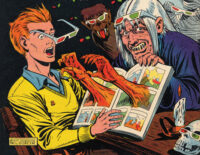The history of the most influential comic book publishers will list two large companies still in business today. They are DC Comics and Marvel. The third important publisher, unique in its own way, very modern, daring, and at times famous for using outrageous covers, was EC Comics.
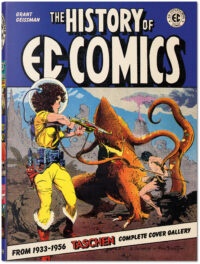 In EC’s early years, then still going by the name of All-American Comics and closely related with DC comics, director M.C. Gaines was responsible for putting out titles featuring The Green Lantern, The Flash, Wonder Woman, Red, White and Blue, Skippy, The Atom, Skribby, Hop Harrigan and other popular characters.
In EC’s early years, then still going by the name of All-American Comics and closely related with DC comics, director M.C. Gaines was responsible for putting out titles featuring The Green Lantern, The Flash, Wonder Woman, Red, White and Blue, Skippy, The Atom, Skribby, Hop Harrigan and other popular characters.
In 1945, he left the company and founded EC and immediately kicked off the Picture Stories line he already had developed at All-American Comics. These titles featured almost any historical theme from Old Testament stories, to American Colonial History, World history and the history of science. And they did something new to the comic book readership, as they actually were educational; hence the name of his newborn company EC, short for Educational Comics (or later Entertaining Comics).
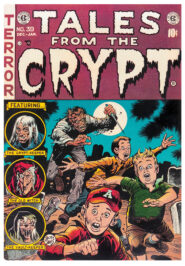 The Picture Stories sold alright, but were not as exciting and tempting as superhero or detective comics for the young readership. Gaines soon started new straightforward action titles, such as Moon Girl and the Prince or Blackstone the Magician and others.
The Picture Stories sold alright, but were not as exciting and tempting as superhero or detective comics for the young readership. Gaines soon started new straightforward action titles, such as Moon Girl and the Prince or Blackstone the Magician and others.
 When in 1947 he died in a tragic boating accident, his son Bill – at first not interested in by the publishing business and his father’s comic book enterprise – took over EC. Then, the “… list of writers and artists who contributed to — and produced some of their best work for — EC reads like a ‘who’s who’ of mid-20th-century comic books, including Al Feldstein, Harvey Kurtzman, Johnny Craig, Jack Davis, Graham Ingels, Wallace Wood, Joe Orlando, Reed Crandall, Al Williamson, Bernie Krigstein, and Frank Frazetta.” Soon the company transformed into something special, and their comic book output became something to remember.
When in 1947 he died in a tragic boating accident, his son Bill – at first not interested in by the publishing business and his father’s comic book enterprise – took over EC. Then, the “… list of writers and artists who contributed to — and produced some of their best work for — EC reads like a ‘who’s who’ of mid-20th-century comic books, including Al Feldstein, Harvey Kurtzman, Johnny Craig, Jack Davis, Graham Ingels, Wallace Wood, Joe Orlando, Reed Crandall, Al Williamson, Bernie Krigstein, and Frank Frazetta.” Soon the company transformed into something special, and their comic book output became something to remember. 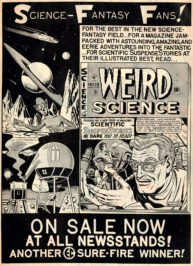
From 1950 onward, EC Comics made a name for itself in the horror comics fan community for publishing first The Crypt of Terror (aka Tales From the Crypt), The Vault of Horror, and then The Haunt of Fear. Ask any comic collector what EC would be most remembered for, he would probably say the horror titles from that era.
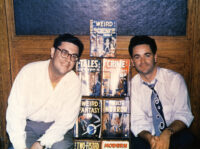
In the early 1950s, with horror and violent detective tales a new trend had emerged, just like cowboy stories, love stories and adventure comics before. EC’s weird titles could also prosper because they had the best artists and ideas for the genre. Particularly, they could rely on one superior artist, namely “Ghastly” Graham Ingels, who left his mark on The Vault of Horror, and later titles of the sort.
“Ingels’s horror tableaus are fetid, swampy, decaying, and oozing, and when depicting a rotting, shambling corpse, he was second to none. As the horror comics developed, Ingels also became known for his interpretation of the grinning visage of The Old Witch.”
Some of their fresh crime comics also featured extremely brutish acts of murder right on the cover, maybe owed to the fact that some artists did both lines.
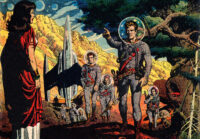 Gaines lines covered subjects intentionally not touched by other houses, as vigilantism, drug addiction, police corruption, bigotry, racism and antisemitism which for the comic publisher usually meant nasty letters to the editors and public uprisings against the company. From today’s point of view, the presentation of such topics was only realistic.
Gaines lines covered subjects intentionally not touched by other houses, as vigilantism, drug addiction, police corruption, bigotry, racism and antisemitism which for the comic publisher usually meant nasty letters to the editors and public uprisings against the company. From today’s point of view, the presentation of such topics was only realistic.
EC’s portfolio of that time not only featured great artwork, but the respective stories became more and more unpredictable and usually had drastic finals, often quite violent ones. (The TV adaptation of Tales from the Crypt, HBO’s 1990s TV series, kept that feature, as the original stories were conceived at EC fifty years earlier. The style of The Twilight Zone, too, is deeply indebted to Gaines). 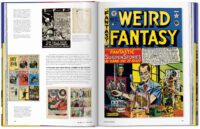
EC later launched Weird Fantasy and Weird Science, before they added war comics – and rather extremely authentic and violent illustrations of warfare, killings, mutilations and torment – to their portfolio. And in 1952 not only was the FBI unhappy with EC‘s depiction of war. Anti-war feelings, pacifist and “subversive” ideas had little room in the minds of most Americans during the Cold War. 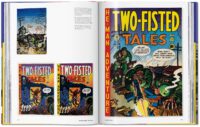
1952 saw the first edition of MAD (then still a comic book), and it featured even better artwork and some groundbreaking satirical works. In short, this magazine saved the company with its parodies and allusions to almost any source, novel, movie or celebrity. MAD earned money for EC, even after in 1953 when Dr. Wertham’s crusade against comics finally forced EC to shut down their horror comic lines.
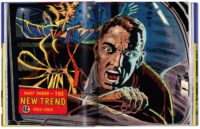 Furthermore, the publications would not receive a seal of approval (easily perceivable on the cover), and postal service would no longer carry them. The accusations presented in hearings and public attacks on Gaines (from today’s point of view entirely ridiculous points) forced him to discontinue EC’s horror and crime comic section for good in 1954. In 1955, MAD was turned into a magazine, to avoid the Comics Code Authority and its restrictive policy of anti-violence.
Furthermore, the publications would not receive a seal of approval (easily perceivable on the cover), and postal service would no longer carry them. The accusations presented in hearings and public attacks on Gaines (from today’s point of view entirely ridiculous points) forced him to discontinue EC’s horror and crime comic section for good in 1954. In 1955, MAD was turned into a magazine, to avoid the Comics Code Authority and its restrictive policy of anti-violence.
Until Gaines sold EC in the 1960s, while at that time, nothing much spectacular was happenening at the company anymore, only MAD proved to be a solid seller.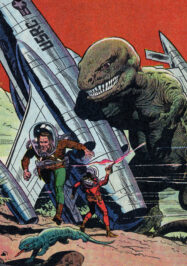
The five large chapters of The History of EC Comics make up for the almost 600 pages and the time until 1956, in which the company’s whole story with incredibly many details is told by comics authority Grant Geissman. He has already published and edited several books on the company and MAD magazine.
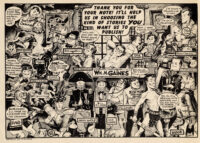 While the first two chapters deal with M.C. Gaines, his leadership covers the years 1933-1947, the third part is probably the most interesting one, as here the emphasis is on the various war, horror, and science fiction titles. The remaining text is devoted to the later 1950s, EC’s aftermath and changes in organization. The last part provides around 80 pages featuring facsimiles of EC‘s complete (!) covers.
While the first two chapters deal with M.C. Gaines, his leadership covers the years 1933-1947, the third part is probably the most interesting one, as here the emphasis is on the various war, horror, and science fiction titles. The remaining text is devoted to the later 1950s, EC’s aftermath and changes in organization. The last part provides around 80 pages featuring facsimiles of EC‘s complete (!) covers.
The History of EC Comics is a fabulous 13-pound hardcover volume that easily will satisfy any serious comic book fan, as it is extremely well-researched and documented. It also provides interesting background information on artists, marketing issues and company politics. The texts are excellent, the more than 1,000 (!) reproductions (mostly in color) come on heavy paper and look fresh from the print shop. Included here are sketches, interior pages and panels, photos, vintage original artwork, splash screens, canceled layouts and many pencil drawings in fantastic quality. The book comes in the English edition only, there is no text in either German or French.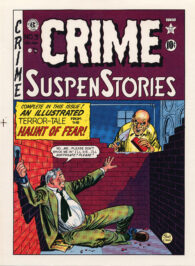
More than 100 rare pictures published for the first time are added as an extra. Many cover reproductions come from Gaines File Copies, the best quality available anywhere. Taschen’s XL comic book history editions keep up with the line’s high standards (they only become heavier with each new installment).
Review by Dr. A. Ebert © 2020
Grant Geissman. The History of EC Comics. Taschen, 2020, 592 p., ISBN 978-3836549769, 13 x 3 x 18.6″

